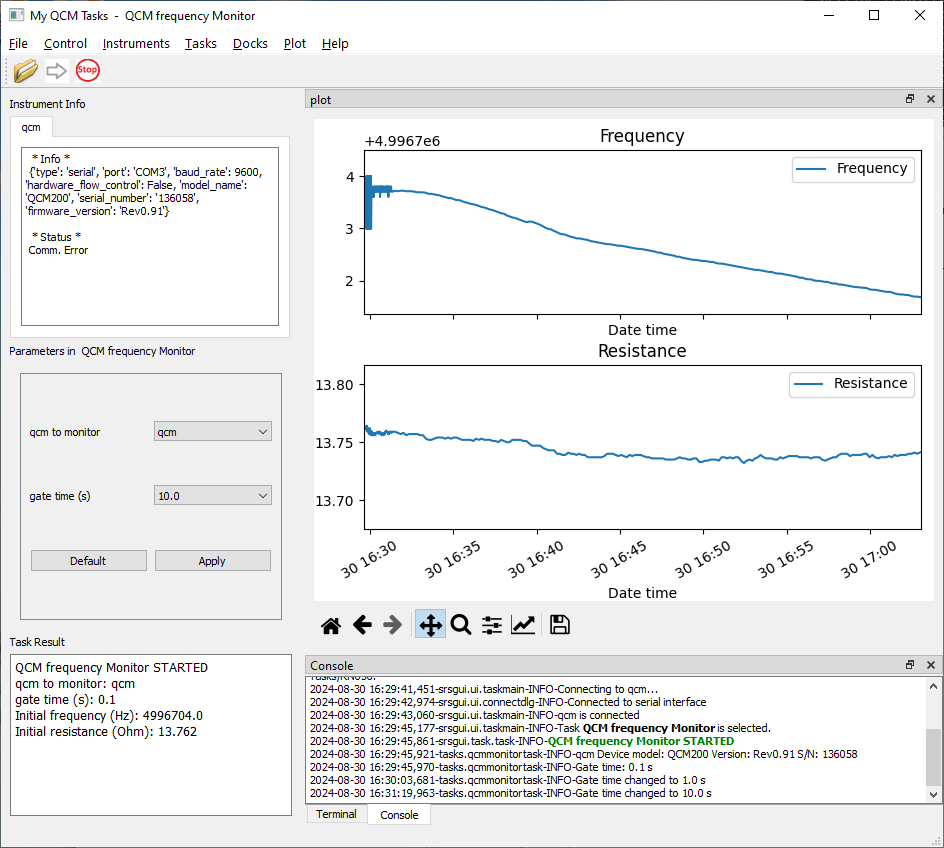Instrument driver package for the Quartz Crystal Microbalance, QCM200 from Stanford Research Systems (SRS)
Project description
srsinst.qcm
srsinst.qcm is a Python package to provide serial communication with the
Quartz Crystal Microbalance, QCM200
from Stanford Research Systems (SRS).
srsinst.qcm uses srsgui package for the support of instrument communication and graphic user interface (GUI).

Installation
You need a working Python 3.7 or later with pip (Python package installer) installed.
If you don't, install Python to your system.
To install srsinst.qcm as an instrument driver , use Python package installer pip from the command line.
python -m pip install srsinst.qcm
To use it as a GUI application, create a virtual environment, if necessary, and install:
python -m pip install srsinst.qcm[full]
Run srsinst.qcm as GUI application
If the Python Scripts directory is in your PATH environment variable, start the application by typing from the command line:
qcm
If not,
python -m srsinst.qcm
will start the GUI application.
Once running the GUI, you can:
- Connect to a QCM200 from the Instruments menu.
- Select a task from the Task menu.
- Press the green arrow to run the selected task.
You can write your own task(s) or modify an existing one and run it from the GUI application, too. For writing a task for the GUI application, refer the document on srsgui package.
Use srsinst.qcm as instrument driver
- Start a Python interpreter, a Jupyter notebook, or an editor of your choice to write a Python script.
- Import the QCM200 class from
srsinst.qcmpackage. - Create an instance of the QCM200 and connect for the serial communication.
|
C:\>python
Python 3.8.3 (tags/v3.8.3:6f8c832, May 13 2020, 22:37:02) [MSC v.1924 64 bit (AMD64)] on win32
Type "help", "copyright", "credits" or "license" for more information.
>>>
>>> from srsinst.qcm import QCM200
>>> qcm = QCM200('serial', 'COM3', 9600)
>>> qcm.check_id()
('QCM200', '136058', 'Rev0.91')
If you get the reply with check_id() method as shown above, you are ready to configure and acquire data from your QCM200.
The remote control and data acquisition of of QCM200 is simple: Select the gate time you want to use among 0.1s, 1.0s, and 10.0s; check if a new set of frequency and resistance data is available; and read data.
>>> # Query the current date time
>>> qcm.cmd.gate_time
0.1
>>> # Change the gate time to 1.0 s
>>> qcm.cmd.gate_time = 1.0
>>> Check if the gate time is changed
>>> qcm.cmd.gate_time
1.0
>>> # Query frequency
>>> qcm.cmd.frequency
4999699.7
>>> # Query resistance
>>> qcm.cmd.resistance
13.756
>>>
You can view all the commands available in the cmd component as following.
>>> qcm.cmd.dir
{'components': {},
'commands': {
'id_string': ('QCMGetCommand', 'I'),
'display_mode': ('DictCommand', 'D'),
'frequency_scale': ('DictCommand', 'V'),
'gate_time': ('DictCommand', 'P'),
'frequency': ('QCMFloatGetCommand', 'F'),
'frequency_offset': ('FloatGetCommand', 'G'),
'resistance': ('QCMFloatGetCommand', 'R'),
'resistance_offset': ('FloatGetCommand', 'S'),
'status': ('QCMIntGetCommand', 'B'),
'timebase': ('DictCommand', 'T')},
'methods': [
'reset_frequency_offset',
'reset_resistance_offset']
}
>>>
For remote command details, refer to the QCM200 manual appendix B.
Here is a simple, yet complete python script to acquire data from a QCM200
using srsinst.qcm package.
import time
from srsinst.qcm import QCM200
GateTime = 1.0 # Select among 0.1 s, 1.0 s, or 10 s
DataAcquisitionTime = 600 # Data collection time in seconds
# Connect to a QCM. Change the address for the COM port used
qcm = QCM200('serial', 'COM3', 9600) # For Linux systems, 'COM3' will be like '/dev/ttyUSB1'.
qcm.cmd.gate_time = GateTime # Set the gate time
output_file = open('qcm-data.txt', 'wt') # Open a file to write data
time_elapsed = 0.0
initial_time = time.time()
while time_elapsed < DataAcquisitionTime:
time_elapsed = time.time() - initial_time
new_data = qcm.get_data_if_both_new() # Data available when Both F and R data are new.
if new_data:
data_format = f'{time_elapsed:7.2f} {new_data[0]:10.2f} {new_data[1]:7.3f}\n'
output_file.write(data_format)
print(data_format, end='')
time.sleep(GateTime - 0.1)
output_file.close()
qcm.disconnect()
The above Python script generates a series of (time, frequency, resistance) data tuples, printed on the screen and saved into a file named 'qcm-data.txt'.
0.00 4996689.10 13.861
0.97 4996689.10 13.861
2.03 4996689.10 13.859
3.10 4996688.90 13.857
.
.
.
Project details
Release history Release notifications | RSS feed
Download files
Download the file for your platform. If you're not sure which to choose, learn more about installing packages.
Source Distribution
Built Distribution
Hashes for srsinst.qcm-0.1.0-py3-none-any.whl
| Algorithm | Hash digest | |
|---|---|---|
| SHA256 | 60e305bbdefcee968045f5355cdb56da54198507a2f3efbfcefb7864338b9875 |
|
| MD5 | 536bab6a8cdf0b44d85ce1fa68474612 |
|
| BLAKE2b-256 | 8ce4fb078d0df41cb8a1e2fbdb3504d00d31c1ca59260035d6545a6088410e84 |










